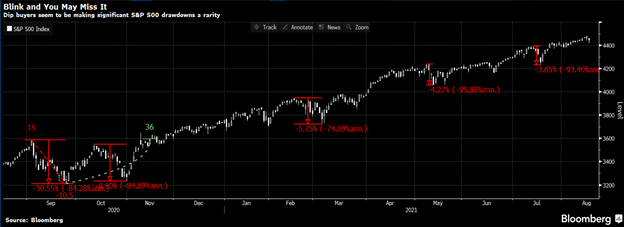August Market Brief
Market Physics – The Unbearable Lightness of Being the S&P 500
“Yeah I’m free, free falling” Tom Petty and the Heartbreakers. Full Moon Fever. 1989
The world works by adhering to simple laws and principles that are universal, with one of those laws being Gravity. Gravity is interesting as it is both a law as well as a theory. Isaac Newton created the Law of Gravity in 1687 and Albert Einstein published his theory on general relativity in 1915. Newton’s Law of Gravitation describes the relationship and formula between force, mass, and distance. Gravity is what keeps us firmly rooted on this planet as it spins at roughly 1,000 miles per hour. But when, if ever, will gravity effect this market? What goes up must come down again, right? We are participating in a gravity defying rally and in rarified historical company. Markets have not only seen historically low volatility but have also rallied nearly 100% off the Pandemic lows back on March 23, 2020.
One part of the equation of Gravitational Law is the Gravitational Constant. For the markets, the one constant is high sensitivity of market returns to changes in Fed Policy. Currently, the Fed is stuck between Easy/Dovish (low rates, lots of bond purchases and liquidity injection that is the current market) and Tight/Hawkish (tapering and rising rates). This has been a historically accommodative Fed for the last few years, which has provided a supercharged “risk on” environment. On August 18th the Fed released its meeting minutes which hinted at beginning to taper its bond purchase program stating this fall. This was the first definite signal that the Fed sees an improved enough market that they feel they can start to step out their support of the market and remove liquidity. This caused a pullback in the markets, but it’s been brief and has not derailed the recovery rally. Neither has the Delta variant spread, unrest in Afghanistan, or any myriad of political risks that may impact market returns.

In the financial world a pullback is seen as a drop of 5-9%, a correction 10-20%, and a Bear Market 20% fall from its highs. Since 1950, the S&P 500 averages three separate -5% pullbacks or greater per year. In 2021 we have not had even one, with our largest so far at -4.23%. As of last Thursday August 18th, the S&P 500 hasn’t fallen by at least -5% off its highs in nearly 200 sessions. This lull in volatility has only happened 8 times in the history of the S&P 500. The longest such quiet period was 404 trading days from June 28, 2016, to Feb. 2, 2018. A correction seems in the cards and would not be surprising considering the weak seasonal period, the recovery off Pandemic lows reaching almost 100% return, and the lack of volatility we have seen so far this year. Gravity will catch up to this market at some point as it’s a law, but we do not think it’s the end of the Bull Market yet.